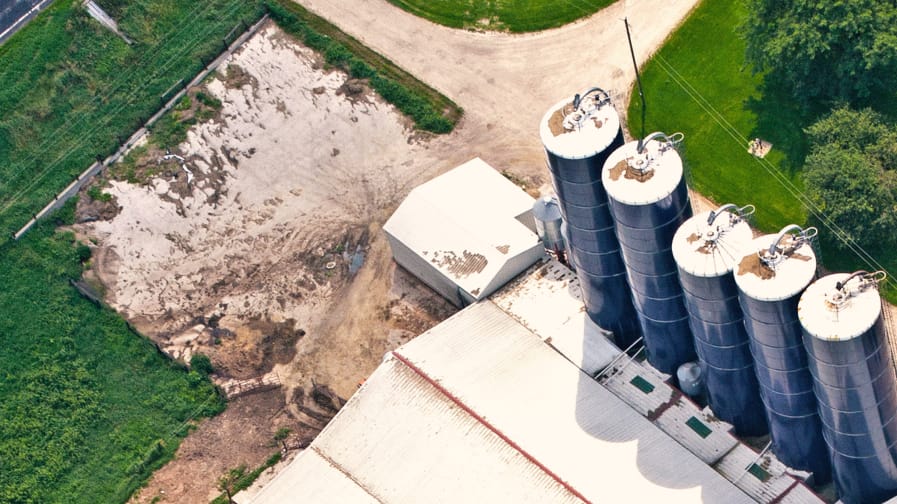How Do Mega-Dairies Perpetuate Environmental Injustices?
Published Jun 22, 2023

Nearly all of New Mexico’s dairy industry growth has occurred in just five southern counties, including Doña Ana — where the infamous stretch of mega-dairies along Interstate 10 from Las Cruces to El Paso, Texas earned the nickname “Dairy Row.”1FWW analysis of USDA NASS. “Quick Stats”; Ogburn (2011). Many of these fence-line communities are low-income areas and/or communities of color, making mega-dairies an environmental justice issue.
According to the U.S. Census Bureau, Anthony — a community along Dairy Row — is over 98 percent Hispanic or Latino, and nearly half of its residents live in poverty.2Border 2012 Texas-New Mexico-Chihuahua Regional Work Group. Public Meeting Minutes. Anthony, New Mexico. November 4, 2010 at 2 to 3; US Census Bureau. “QuickFacts: Anthony city, New Mexico.” Available at https://www.census.gov/quickfacts/fact/table/anthonycitynewmexico/PST045219. Accessed September 2020. Despite New Mexico’s 2006 executive order requiring agencies to consider disproportionate impacts when permitting industrial operations like mega-dairies, the policy is “more sentiment than substance.”3Shephard, Arla and Ray Ring. “The environment…is where we live.” High Country News. February 1, 2010; Border 2012 Texas-New Mexico-Chihuahua Regional Work Group (2010) at 2. Community members testify feeling as though they have “no political standing” to push back against the dairy industry, and have frustration toward regulators for failing to protect them. One resident asked pointedly, “Are we ‘real citizens’ or not?”4Border 2012 Texas-New Mexico-Chihuahua Regional Work Group (2010) at 1 to 4.
While the dairy industry generates billions of dollars annually, local communities do not necessarily benefit, with mega-dairies instead reducing property values of nearby homes. Decades of research uphold that mega-dairies and other factory farms “are fundamentally incompatible with rural regional economic development” and are linked to higher levels of unemployment and poverty.5Weida, William J. The Colorado College. “A synopsis of potential impacts from dairies on a regional economy.” March 1, 2003 at 2; Lobao, Linda and Curtis W. Stofferahn. “The community effects of industrialized farming: Social science research and challenges to corporate farming laws.” Agriculture and Human Values. Vol. 25, Iss. 2. June 2008 at 220 to 221 and 225; Durrenberger, E. Paul and Kendall M. Thu. “The expansion of large scale hog farming in Iowa: The applicability of Goldschmidt’s findings fifty years later.” Human Organization. Vol. 55, No. 4. Winter 1996 at 411 to 412; Lyson, Thomas A. and Rick Welsh. “Agricultural industrialization, anticorporate farming laws, and rural community welfare.” Environment and Planning A: Economy and Space. Vol. 37, Iss. 8. August 1, 2005 at 1487 to 1488.
On top of this, these communities bear the brunt of mega-dairy pollution. Flies and foul odors prevent residents from spending time outdoors or even opening their windows.6Weida (2003) at 1 to 2; Border 2012 Texas-New Mexico-Chihuahua Regional Work Group (2010) at 2 to 3. The odors are not just a nuisance, but a mix of toxic pollutants that contribute to health issues including headaches, fatigue, and asthma.7Schultz, Amy A. et al. “Residential proximity to concentrated animal feeding operations and allergic and respiratory disease.” Environment International. Vol. 130. September 2019 at 1; Von Essen, Susanna G. and Brent W. Auvermann. “Health effects from breathing air near CAFOs for feeder cattle or hogs.” Journal of Agromedicine. Vol. 10, No. 4. 2005 at 59; Wing, Steve and Susanne Wolf. “Intensive livestock operations, health, and quality of life among eastern North Carolina residents.” Environmental Health Perspectives. Vol. 108, No. 3. March 2000 at 233 to 235 and 237. Mega-dairies also emit greenhouse gases, like methane and nitrous oxide, that fuel the climate crisis.8Gerber, P. J. et al. (2013). Tackling Climate Change Through Livestock: A Global Assessment of Emissions and Mitigation Opportunities. Rome: Food and Agriculture Organization of the United Nations at xii and 20.
Endnotes


